ECO mode Alfa Romeo GT 2005 Owner handbook (in English)
[x] Cancel search | Manufacturer: ALFA ROMEO, Model Year: 2005, Model line: GT, Model: Alfa Romeo GT 2005Pages: 307, PDF Size: 6.05 MB
Page 6 of 307
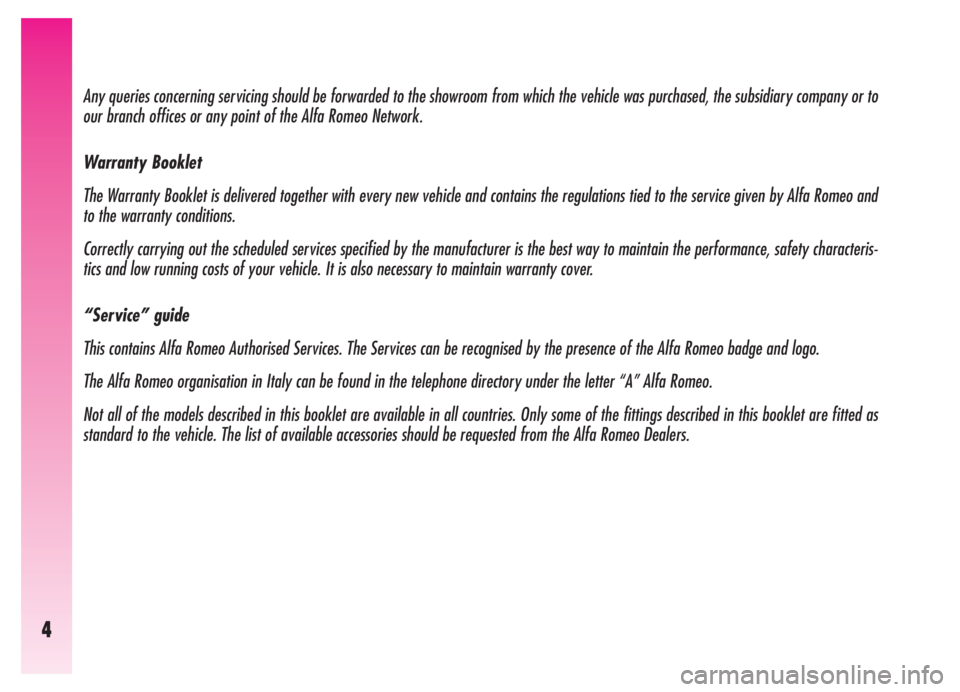
4
Any queries concerning servicing should be forwarded to the showroom from which the vehicle was purchased, the subsidiary company or to
our branch offices or any point of the Alfa Romeo Network.
Warranty Booklet
The Warranty Booklet is delivered together with every new vehicle and contains the regulations tied to the service given by Alfa Romeo and
to the warranty conditions.
Correctly carrying out the scheduled services specified by the manufacturer is the best way to maintain the performance, safety characteris-
tics and low running costs of your vehicle. It is also necessary to maintain warranty cover.
“Service” guide
This contains Alfa Romeo Authorised Services. The Services can be recognised by the presence of the Alfa Romeo badge and logo.
The Alfa Romeo organisation in Italy can be found in the telephone directory under the letter “A” Alfa Romeo.
Not all of the models described in this booklet are available in all countries. Only some of the fittings described in this booklet are fitted as
standard to the vehicle. The list of available accessories should be requested from the Alfa Romeo Dealers.
Page 14 of 307
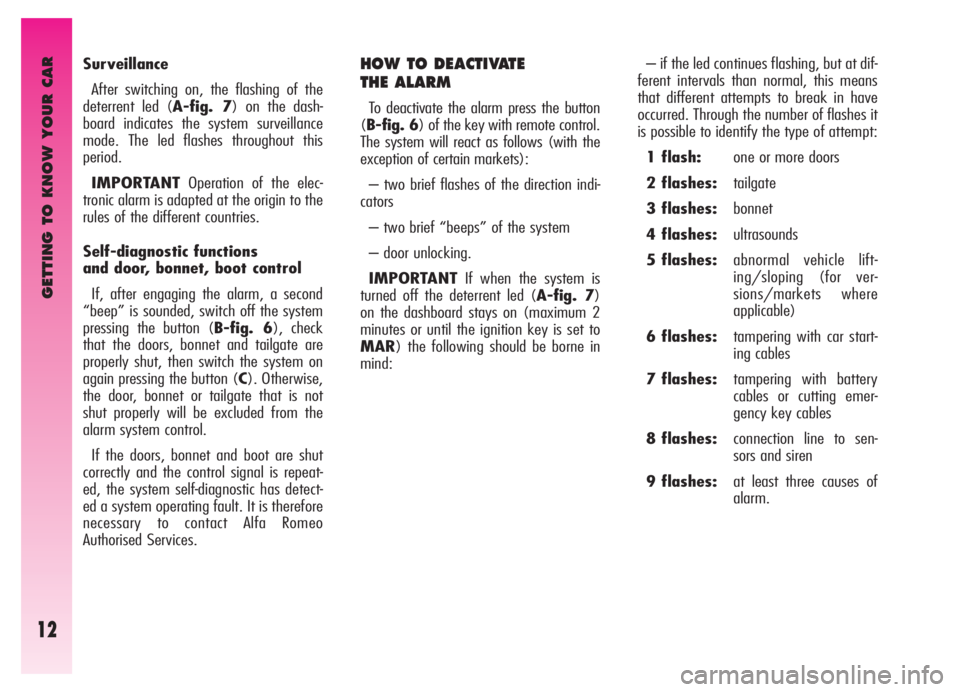
GETTING TO KNOW YOUR CAR
12
– if the led continues flashing, but at dif-
ferent intervals than normal, this means
that different attempts to break in have
occurred. Through the number of flashes it
is possible to identify the type of attempt:
1 flash:one or more doors
2 flashes:tailgate
3 flashes:bonnet
4 flashes:ultrasounds
5 flashes:abnormal vehicle lift-
ing/sloping (for ver-
sions/markets where
applicable)
6 flashes:tampering with car start-
ing cables
7 flashes:tampering with battery
cables or cutting emer-
gency key cables
8 flashes:connection line to sen-
sors and siren
9 flashes:at least three causes of
alarm. Surveillance
After switching on, the flashing of the
deterrent led (A-fig. 7) on the dash-
board indicates the system surveillance
mode. The led flashes throughout this
period.
IMPORTANTOperation of the elec-
tronic alarm is adapted at the origin to the
rules of the different countries.
Self-diagnostic functions
and door, bonnet, boot control
If, after engaging the alarm, a second
“beep” is sounded, switch off the system
pressing the button (B-fig. 6), check
that the doors, bonnet and tailgate are
properly shut, then switch the system on
again pressing the button (C). Otherwise,
the door, bonnet or tailgate that is not
shut properly will be excluded from the
alarm system control.
If the doors, bonnet and boot are shut
correctly and the control signal is repeat-
ed, the system self-diagnostic has detect-
ed a system operating fault. It is therefore
necessary to contact Alfa Romeo
Authorised Services.HOW TO DEACTIVATE
THE ALARM
To deactivate the alarm press the button
(B-fig. 6) of the key with remote control.
The system will react as follows (with the
exception of certain markets):
– two brief flashes of the direction indi-
cators
– two brief “beeps” of the system
– door unlocking.
IMPORTANTIf when the system is
turned off the deterrent led (A-fig. 7)
on the dashboard stays on (maximum 2
minutes or until the ignition key is set to
MAR) the following should be borne in
mind:
Page 26 of 307
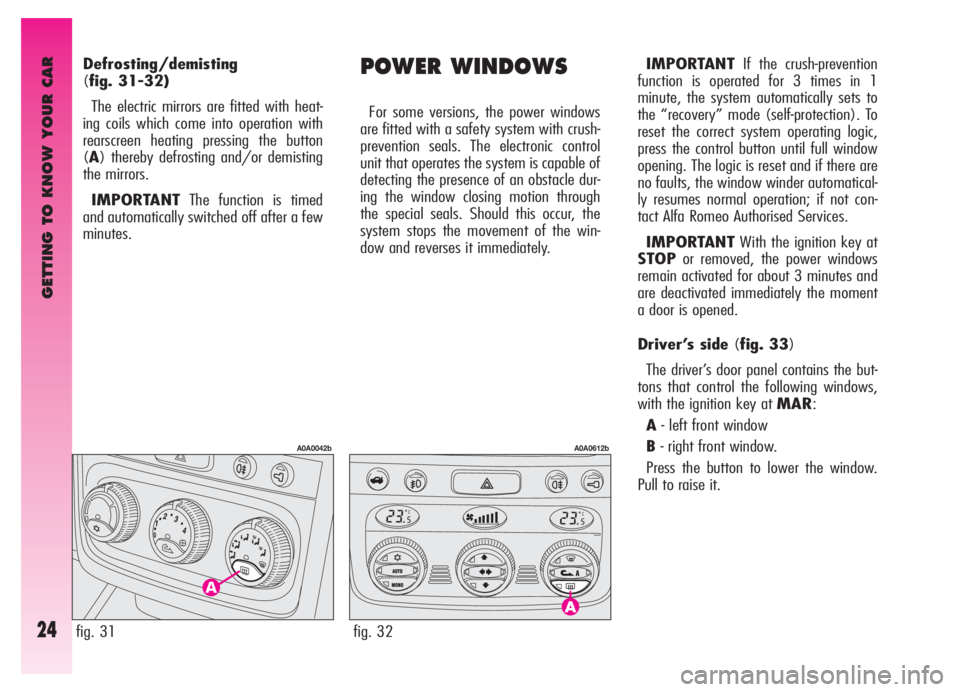
GETTING TO KNOW YOUR CAR
24
POWER WINDOWS
For some versions, the power windows
are fitted with a safety system with crush-
prevention seals. The electronic control
unit that operates the system is capable of
detecting the presence of an obstacle dur-
ing the window closing motion through
the special seals. Should this occur, the
system stops the movement of the win-
dow and reverses it immediately.IMPORTANTIf the crush-prevention
function is operated for 3 times in 1
minute, the system automatically sets to
the “recovery” mode (self-protection). To
reset the correct system operating logic,
press the control button until full window
opening. The logic is reset and if there are
no faults, the window winder automatical-
ly resumes normal operation; if not con-
tact Alfa Romeo Authorised Services.
IMPORTANTWith the ignition key at
STOPor removed, the power windows
remain activated for about 3 minutes and
are deactivated immediately the moment
a door is opened.
Driver’s side (fig. 33)
The driver’s door panel contains the but-
tons that control the following windows,
with the ignition key at MAR:
A- left front window
B- right front window.
Press the button to lower the window.
Pull to raise it. Defrosting/demisting
(fig. 31-32)
The electric mirrors are fitted with heat-
ing coils which come into operation with
rearscreen heating pressing the button
(A) thereby defrosting and/or demisting
the mirrors.
IMPORTANTThe function is timed
and automatically switched off after a few
minutes.
fig. 32
A0A0612b
fig. 31
A0A0042b
Page 60 of 307

GETTING TO KNOW YOUR CAR
58
CLOCK(fig. 76)
Adjusting the hours
Press the MODE button in
Q, the hours
will flash. Set the hour required using button
âorã.
Every press on the button will increase
by one unit.
Keeping the button pressed obtains auto-
matic fast increase or decrease.
When you are near the value required,
release the control and complete adjust-
ment with single presses.
Then press the MODE button in
Rto
store.
fig. 76Adjusting the minutes
Press the MODE button twice in
Q,
the minutes will flash. Set the minutes
required using button
âorã.
Every press on the button will increase
by one unit.
Keeping the button pressed obtains auto-
matic fast increase or decrease.
When you are near the value required,
release the control and complete adjust-
ment with single presses.
Then press the MODE button in
Rto
store.
OUTSIDE TEMPERATURE (fig. 76)
Outside temperature can be viewed on
the display lower side, under the hour indi-
cation. When the outside temperature is
below or 3° C, the indicator starts flashing
together with the buzzer, to warn the dri-
ver about the possible presence of ice on
the road. The acoustic signal lasts about 2
seconds, while the outside temperature
indicator flashes for about 10 seconds.
The signal of possible presence of ice on
the road is repeated only if the outside
temperature is over 6° C and then reach-
es again 3° C.
A0A0009b
fig. 77
A0A0083b
BUZZER(fig. 77-78)
The buzzer which accompanies the con-
trols may be activated (
ON) or deactivat-
ed (
OFF); proceed as follows:
Press the MODE button 3 times in
Q,
then use button
âorã, to turn the
buzzer on or off.
The press the MODE button in
Rto
store the condition chosen.
clock and outside temperature display
buzzer activated display (ON)
Page 62 of 307
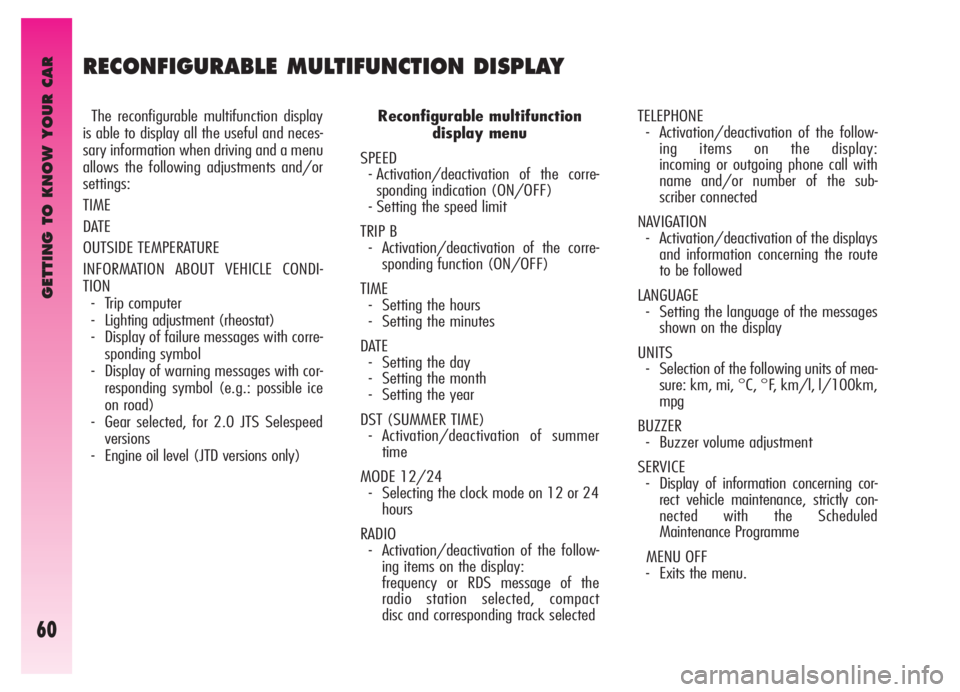
GETTING TO KNOW YOUR CAR
60
RECONFIGURABLE MULTIFUNCTION DISPLAY
The reconfigurable multifunction display
is able to display all the useful and neces-
sary information when driving and a menu
allows the following adjustments and/or
settings:
TIME
DATE
OUTSIDE TEMPERATURE
INFORMATION ABOUT VEHICLE CONDI-
TION
- Trip computer
- Lighting adjustment (rheostat)
- Display of failure messages with corre-
sponding symbol
- Display of warning messages with cor-
responding symbol (e.g.: possible ice
on road)
- Gear selected, for 2.0 JTS Selespeed
versions
- Engine oil level (JTD versions only)Reconfigurable multifunction
display menu
SPEED
- Activation/deactivation of the corre-
sponding indication (ON/OFF)
- Setting the speed limit
TRIP B
- Activation/deactivation of the corre-
sponding function (ON/OFF)
TIME
- Setting the hours
- Setting the minutes
DATE
- Setting the day
- Setting the month
- Setting the year
DST (SUMMER TIME)
- Activation/deactivation of summer
time
MODE 12/24
- Selecting the clock mode on 12 or 24
hours
RADIO
- Activation/deactivation of the follow-
ing items on the display:
frequency or RDS message of the
radio station selected, compact
disc and corresponding track selectedTELEPHONE
- Activation/deactivation of the follow-
ing items on the display:
incoming or outgoing phone call with
name and/or number of the sub-
scriber connected
NAVIGATION
- Activation/deactivation of the displays
and information concerning the route
to be followed
LANGUAGE
- Setting the language of the messages
shown on the display
UNITS
- Selection of the following units of mea-
sure: km, mi, °C, °F, km/l, l/100km,
mpg
BUZZER
- Buzzer volume adjustment
SERVICE
- Display of information concerning cor-
rect vehicle maintenance, strictly con-
nected with the Scheduled
Maintenance Programme
MENU OFF
- Exits the menu.
Page 67 of 307
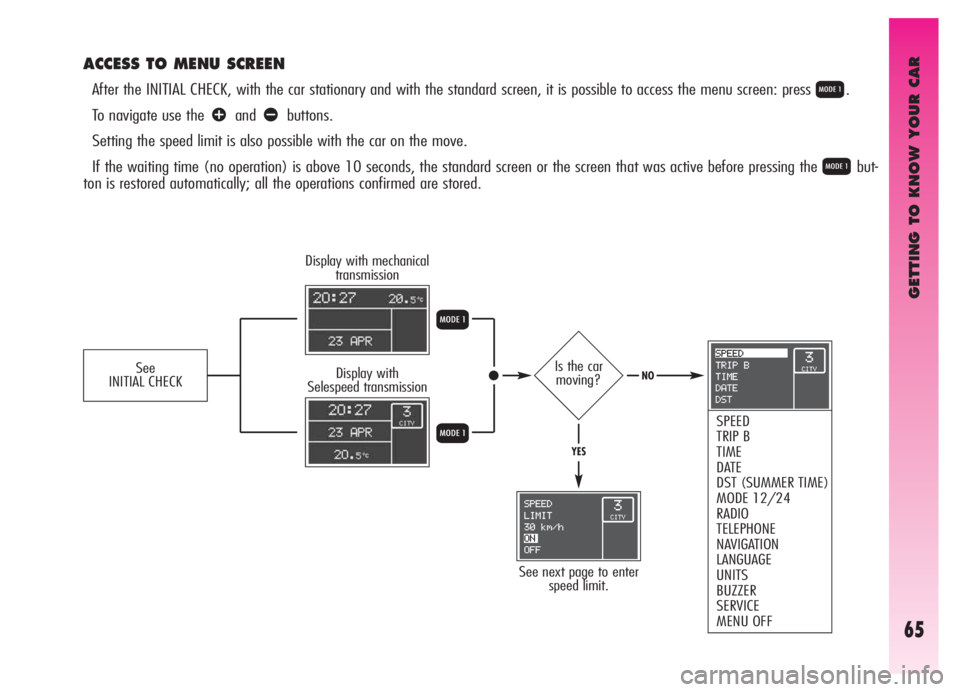
GETTING TO KNOW YOUR CAR
65
ACCESS TO MENU SCREEN
After the INITIAL CHECK, with the car stationary and with the standard screen, it is possible to access the menu screen: press Q.
To navigate use the
âandãbuttons.
Setting the speed limit is also possible with the car on the move.
If the waiting time (no operation) is above 10 seconds, the standard screen or the screen that was active before pressing the
Qbut-
ton is restored automatically; all the operations confirmed are stored.
Display with mechanical
transmission
Display with
Selespeed transmissionIs the car
moving?
See next page to enter
speed limit.
SPEED
TRIP B
TIME
DATE
DST (SUMMER TIME)
MODE 12/24
RADIO
TELEPHONE
NAVIGATION
LANGUAGE
UNITS
BUZZER
SERVICE
MENU OFF
Q
Q
See
INITIAL CHECKNO
YES
Page 92 of 307

GETTING TO KNOW YOUR CAR
90
Warning
light on dialMessage
on display
U
EOBD ENGINE CONTROL SYSTEM FAILURE
In normal conditions, turning the ignition key to MAR, the warning light turns on, but it should
go off when the engine has started. The initial turning on indicates that the warning light is work-
ing properly.
If the warning light stays on or turns on when travelling (on some versions the message + sym-
bol are shown on the reconfigurable multifunction display):
glowing steadily- means a fault in the supply/ignition system which could cause high emis-
sions at the exhaust, possible lack of performance, poor handling and high consumption levels.
In these conditions it is possible to continue driving without however demanding heavy effort or
high speeds. Prolonged use of the vehicle with the warning light on may cause damage. Contact
Alfa Romeo Authorised Services as soon as possible.
The warning light goes off if the fault disappears, but it is still stored by the system;
flashing- indicates the possibility of damage to catalyst (see “EOBD system” in the chapter).
If the warning light flashes, it is necessary to release the accelerator pedal to lower the speed
of the engine until the warning light stops flashing; continue the journey at moderate speed, try-
ing to avoid driving conditions that may cause further flashing and contact Alfa Romeo Authorised
Services as soon as possible.
If, turning the ignition key to MAR, the Uwarning light does not
turn on or if it turns on glowing steadily or flashing when travelling,
contact Alfa Romeo Authorised Services as soon as possible.
Page 130 of 307
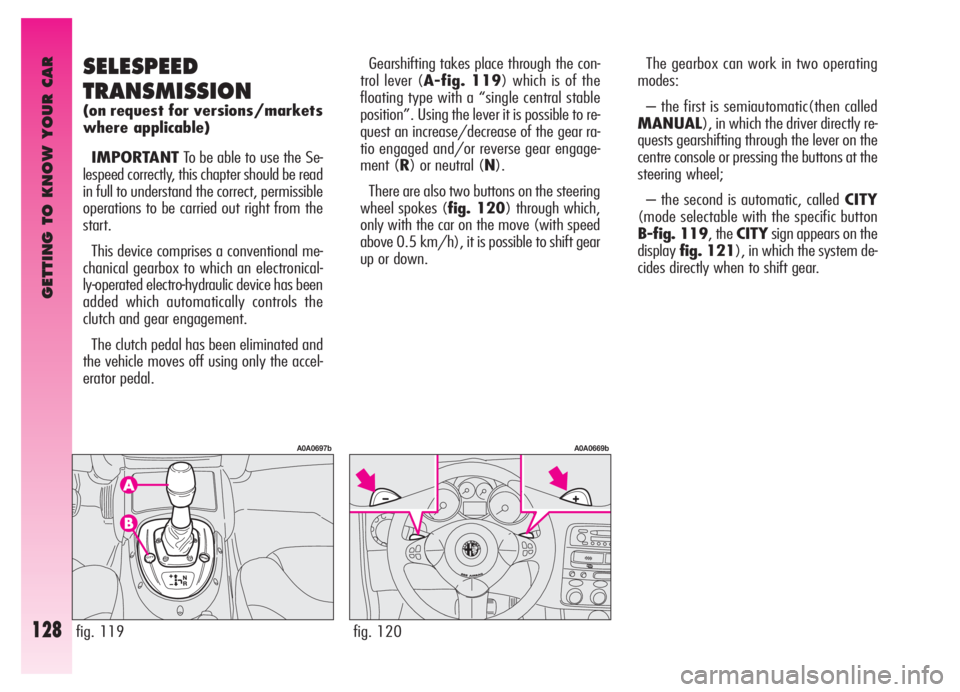
GETTING TO KNOW YOUR CAR
128
The gearbox can work in two operating
modes:
– the first is semiautomatic(then called
MANUAL), in which the driver directly re-
quests gearshifting through the lever on the
centre console or pressing the buttons at the
steering wheel;
– the second is automatic, calledCITY
(mode selectable with the specific button
B-fig. 119, the CITYsign appears on the
displayfig. 121), in which the system de-
cides directly when to shift gear.SELESPEED
TRANSMISSION
(on request for versions/markets
where applicable)
IMPORTANTTo be able to use the Se-
lespeed correctly, this chapter should be read
in full to understand the correct, permissible
operations to be carried out right from the
start.
This device comprises a conventional me-
chanical gearbox to which an electronical-
ly-operated electro-hydraulic device has been
added which automatically controls the
clutch and gear engagement.
The clutch pedal has been eliminated and
the vehicle moves off using only the accel-
erator pedal.Gearshifting takes place through the con-
trol lever (A-fig. 119) which is of the
floating type with a “single central stable
position”. Using the lever it is possible to re-
quest an increase/decrease of the gear ra-
tio engaged and/or reverse gear engage-
ment (R) or neutral (N).
There are also two buttons on the steering
wheel spokes (fig. 120) through which,
only with the car on the move (with speed
above 0.5 km/h), it is possible to shift gear
up or down.
fig. 119
A0A0697b
fig. 120
A0A0669b
Page 131 of 307
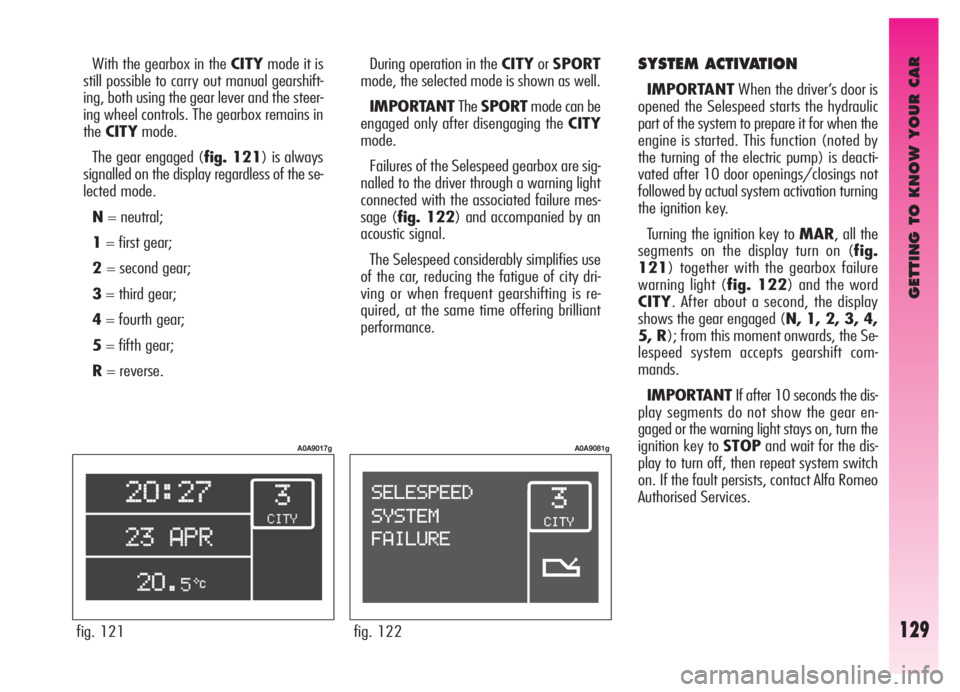
GETTING TO KNOW YOUR CAR
129
SYSTEM ACTIVATION
IMPORTANTWhen the driver’s door is
opened the Selespeed starts the hydraulic
part of the system to prepare it for when the
engine is started. This function (noted by
the turning of the electric pump) is deacti-
vated after 10 door openings/closings not
followed by actual system activation turning
the ignition key.
Turning the ignition key to MAR, all the
segments on the display turn on (fig.
121) together with the gearbox failure
warning light (fig. 122) and the word
CITY. After about a second, the display
shows the gear engaged (N, 1, 2, 3, 4,
5, R); from this moment onwards, the Se-
lespeed system accepts gearshift com-
mands.
IMPORTANTIf after 10 seconds the dis-
play segments do not show the gear en-
gaged or the warning light stays on, turn the
ignition key to STOPand wait for the dis-
play to turn off, then repeat system switch
on. If the fault persists, contact Alfa Romeo
Authorised Services. With the gearbox in the CITYmode it is
still possible to carry out manual gearshift-
ing, both using the gear lever and the steer-
ing wheel controls. The gearbox remains in
theCITYmode.
The gear engaged (fig. 121) is always
signalled on the display regardless of the se-
lected mode.
N= neutral;
1= first gear;
2= second gear;
3= third gear;
4= fourth gear;
5= fifth gear;
R= reverse.During operation in the CITYorSPORT
mode, the selected mode is shown as well.
IMPORTANTTheSPORTmode can be
engaged only after disengaging the CITY
mode.
Failures of the Selespeed gearbox are sig-
nalled to the driver through a warning light
connected with the associated failure mes-
sage (fig. 122) and accompanied by an
acoustic signal.
The Selespeed considerably simplifies use
of the car, reducing the fatigue of city dri-
ving or when frequent gearshifting is re-
quired, at the same time offering brilliant
performance.
fig. 121
A0A9017g
fig. 122
A0A9081g
Page 132 of 307
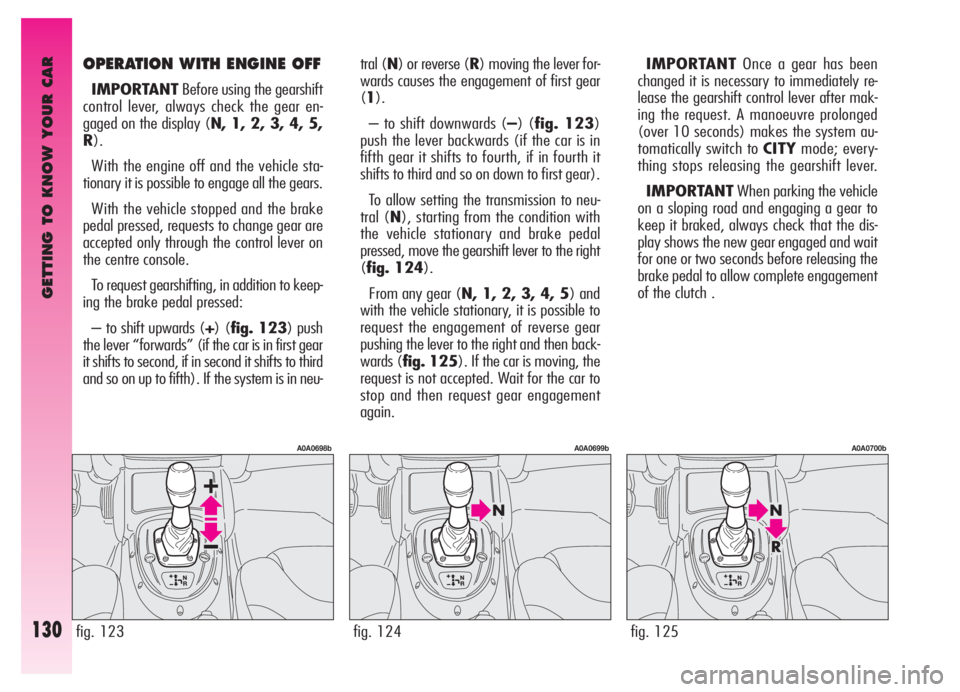
GETTING TO KNOW YOUR CAR
130
IMPORTANTOnce a gear has been
changed it is necessary to immediately re-
lease the gearshift control lever after mak-
ing the request. A manoeuvre prolonged
(over 10 seconds) makes the system au-
tomatically switch to CITYmode; every-
thing stops releasing the gearshift lever.
IMPORTANTWhen parking the vehicle
on a sloping road and engaging a gear to
keep it braked, always check that the dis-
play shows the new gear engaged and wait
for one or two seconds before releasing the
brake pedal to allow complete engagement
of the clutch .
fig. 125
A0A0700b
OPERATION WITH ENGINE OFF
IMPORTANTBefore using the gearshift
control lever, always check the gear en-
gaged on the display (N, 1, 2, 3, 4, 5,
R).
With the engine off and the vehicle sta-
tionary it is possible to engage all the gears.
With the vehicle stopped and the brake
pedal pressed, requests to change gear are
accepted only through the control lever on
the centre console.
To request gearshifting, in addition to keep-
ing the brake pedal pressed:
– to shift upwards (+) (fig. 123) push
the lever “forwards” (if the car is in first gear
it shifts to second, if in second it shifts to third
and so on up to fifth). If the system is in neu-tral (N) or reverse (R) moving the lever for-
wards causes the engagement of first gear
(1).
– to shift downwards (–) (fig. 123)
push the lever backwards (if the car is in
fifth gear it shifts to fourth, if in fourth it
shifts to third and so on down to first gear).
To allow setting the transmission to neu-
tral (N), starting from the condition with
the vehicle stationary and brake pedal
pressed, move the gearshift lever to the right
(fig. 124).
From any gear (N, 1, 2, 3, 4, 5) and
with the vehicle stationary, it is possible to
request the engagement of reverse gear
pushing the lever to the right and then back-
wards (fig. 125). If the car is moving, the
request is not accepted. Wait for the car to
stop and then request gear engagement
again.
fig. 123
A0A0698b
fig. 124
A0A0699b